Hyperbaric oxygen therapy ameliorates TNBS-induced acute distal colitis in rats
- PMID: 25926972
- PMCID: PMC4414439
- DOI: 10.1186/s13618-015-0026-2
Hyperbaric oxygen therapy ameliorates TNBS-induced acute distal colitis in rats
Abstract
Background: This study investigated the therapeutic effects of hyperbaric oxygen in experimental acute distal colitis focusing on its effect on the production of pro-inflammatory cytokines, nitric oxide and hypoxia-inducible factor 1alpha.
Methods: Colitis was induced with a rectal infusion of 150 mg/kg of TNBS under anesthesia with Ketamine (50 mg/kg) and Xylazine (10 mg/kg). Control animals received only rectal saline. After colitis induction, animals were subjected to two sessions of hyperbaric oxygen and were then euthanized. The distal intestine was resected for macroscopic analysis, determination of myeloperoxidase activity, western-blotting analyses of inducible nitric oxide synthase and cyclooxygenase-2 expression and immunohistochemical analysis of hypoxia-inducible factor 1alpha and cyclooxygenase-2. Cytokines levels in the distal intestine were measured using an enzyme-linked immunosorbent assay.
Results: Hyperbaric oxygen therapy attenuated the severity of acute distal colitis, with reduced macroscopic damage score. This effect was associated with prevention in the increase of pro-inflammatory cytokine production; myeloperoxidase activity, in the expression of inducible nitric oxide synthase and cyclooxygenase-2. Finally, hyperbaric oxygen inhibited the acute distal colitis-induced up-regulation of hypoxia-inducible factor 1alpha.
Conclusions: The results indicate that hyperbaric oxygen attenuates the severity of acute distal colitis through the down-regulation of pro-inflammatory events.
Keywords: Cytokines; Experimental colitis; Hyperbaric oxygen; Hypoxia; Inflammatory bowel diseases.
Figures
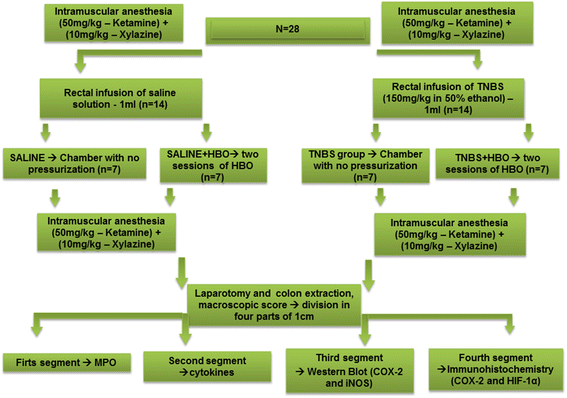
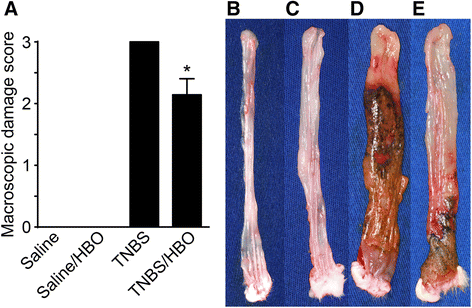
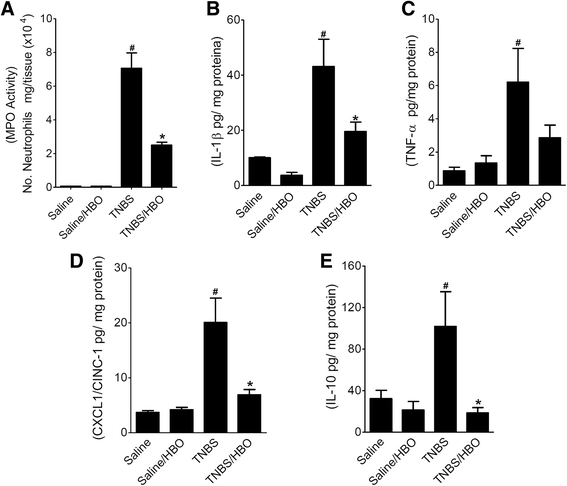
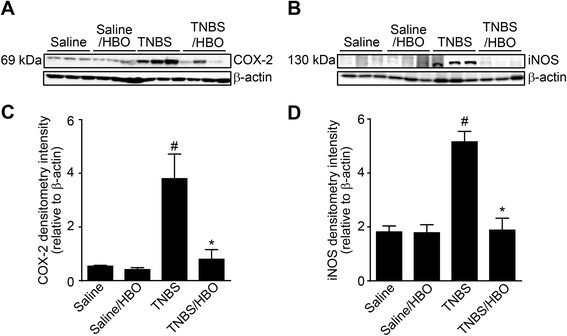
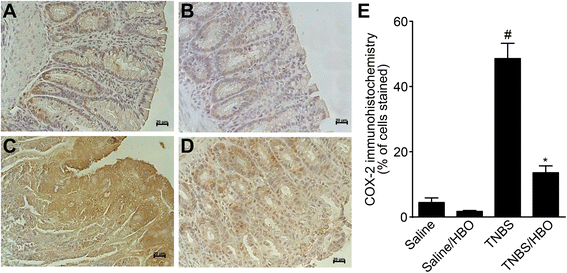
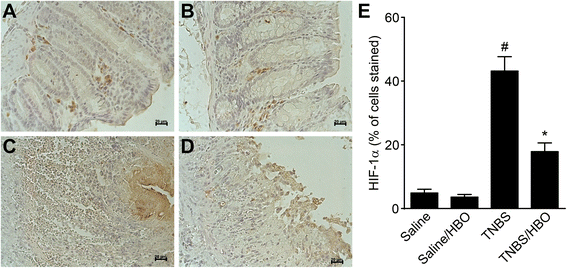
Similar articles
-
Down-regulation of hypoxia-inducible factor-1alpha by hyperbaric oxygen attenuates the severity of acute pancreatitis in rats.Pancreas. 2009 Jul;38(5):515-22. doi: 10.1097/MPA.0b013e31819cac24. Pancreas. 2009. PMID: 19287337
-
Inhibition of endogenous nitric oxide activity impairs the colonic sparing effect of rofecoxib, the cyclooxygenase-2 inhibitor and resveratrol, the preferential cyclooxygenase-1 inhibitor in the course of experimental colitis. Role of oxidative stress biomarkers and proinflammatory cytokines.J Physiol Pharmacol. 2023 Oct;74(5). doi: 10.26402/jpp.2023.5.08. Epub 2023 Dec 6. J Physiol Pharmacol. 2023. PMID: 38085520
-
Implication of TNF-alpha convertase (TACE/ADAM17) in inducible nitric oxide synthase expression and inflammation in an experimental model of colitis.Cytokine. 2001 Dec 21;16(6):220-6. doi: 10.1006/cyto.2001.0969. Cytokine. 2001. PMID: 11884025
-
Role of nitric oxide in the impairment of circular muscle contractility of distended, uninflamed mid-colon in TNBS-induced acute distal colitis in rats.World J Gastroenterol. 2005 Sep 28;11(36):5677-84. doi: 10.3748/wjg.v11.i36.5677. World J Gastroenterol. 2005. PMID: 16237764 Free PMC article.
-
Influence of simultaneous inhibition of cyclooxygenase-2 and inducible nitric oxide synthase in experimental colitis in rats.Inflammopharmacology. 2007 Oct;15(5):188-95. doi: 10.1007/s10787-007-1603-3. Inflammopharmacology. 2007. PMID: 17943250
Cited by
-
New Beginnings for Medical Gas Research.Med Gas Res. 2016 Apr 4;6(1):1-2. doi: 10.4103/2045-9912.179336. eCollection 2016 Mar. Med Gas Res. 2016. PMID: 27826416 Free PMC article. No abstract available.
-
For the pursuit of oxygen and carbon dioxide channels in mitochondria.Med Gas Res. 2016 Dec 30;6(4):237-238. doi: 10.4103/2045-9912.196908. eCollection 2016 Oct-Dec. Med Gas Res. 2016. PMID: 28217298 Free PMC article. No abstract available.
-
The new insights of hyperbaric oxygen therapy: focus on inflammatory bowel disease.Precis Clin Med. 2024 Jan 18;7(1):pbae001. doi: 10.1093/pcmedi/pbae001. eCollection 2024 Mar. Precis Clin Med. 2024. PMID: 38344218 Free PMC article. Review.
-
Neuroprotective effect of hyperbaric oxygen therapy in a juvenile rat model of repetitive mild traumatic brain injury.Med Gas Res. 2016 Dec 30;6(4):187-193. doi: 10.4103/2045-9912.196900. eCollection 2016 Oct-Dec. Med Gas Res. 2016. PMID: 28217290 Free PMC article.
-
Effects of Dietary Oat Beta-Glucans on Colon Apoptosis and Autophagy through TLRs and Dectin-1 Signaling Pathways-Crohn's Disease Model Study.Nutrients. 2021 Jan 22;13(2):321. doi: 10.3390/nu13020321. Nutrients. 2021. PMID: 33499397 Free PMC article.
References
LinkOut - more resources
Full Text Sources
Other Literature Sources
Research Materials

